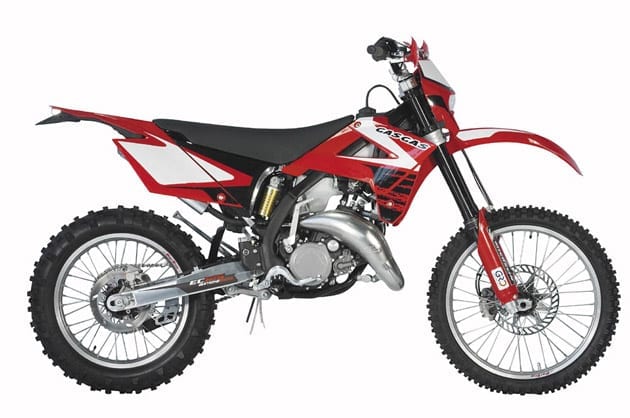YAMA' Daba Duo
By TMX Archives on 8th Feb 07

FOR an enduro machine test you would have thought we would need an enduro-type setting, so the T+MX A Tester Team of Johnno White and a wee Scotsman decided to find to find some proper enduro terrain to ride the shiny new 2007 Yamaha WR250 and 450F thumpers.
So they ventured to Junction 37 of the M6 near Kendal where they had 100 acres of very varied and interesting Cumbrian countryside, owned by the Westmorland club, to play with.
It was easy to see both machines have undergone some pretty big changes...
Both the WR250F and WR450F come with a lightweight aluminium semi-double cradle frame for 2007. The frames are almost identical to those on the 2006 YZF motocross models. The frame change was a main aim for the Yam technical bods to give the WR range a smaller, lighter and quicker-steering machine - great for the rider, straight from the box. With the frame changes came a new engine oil placement for the WR250F. Once held in the steel front downtube, the 250F uses an oil reservoir that sits against the front of the cases between the wishbone spars and is the same version used on the '06 YZ250F.
In moving the lube from the upper frame to the bottom of the engine it drops the centre of gravity which aids mass centralisation.
Yamaha has moved away from the external oil tank idea with the 450F and instead contains all its oil inside the new engine cases.
Although both bikes have bigger fuel tanks than the YZF they are complemented with the same slick looking rad scoops as the motocross range. Both tanks are big enough to take eight litres on board so you are not likely to run out on a big trek across some moorland or forest track.
Behind both rad scoops there are two bigger radiators than '06 to prevent overheating, with both bikes having the radiator's catch tanks placed under the rear mud-guard.
Both machines come with a lower seat height than on previous models and lower foot rests to enhance rider control.
They both come with Pro Taper 'bars with a lightweight, forged aluminium upper triple clamp, a one piece plastic sump guard, quick-access airbox, massive footpegs and an ultra-chic LED tail light sits comfortably under the YZ-style rear mud-guard.
As far as the brakes are concerned they are both fitted with wavy style discs front and rear to offer improved braking under extreme conditions.
Kayaba is the choice of suspension front and rear.
Also new for 2007 on the WR range is a dry sump. The 250 holds 1.4 litres where the 450 holds surprisingly less, 1.2 litres to be accurate.
Both bikes have five-speed gear boxes, the 250F's box sees the first two gears unchanged, but the final three are brought closer together to try and ensure that the little motor doesn't get bogged down. A 50 tooth sprocket has been bolted on this season to replace the shorter 52T of '06.
The 450s box goes new too with wide ratio set of gears to help increase low to mid-range performance.
At the front end the cool digital enduro computer offers speedometer, clock, trip meter in basic mode or when in race mode it functions as a timer and distance compensating trip meter.
YAMAHA WR250F...
Johnno writes...
THE first bike I rode was the DOHC five-valve WR250F and straight away I could see why the WR range would prove popular with enduro and trail riders alike.
Yes, you have guessed it, one button on the handlebars - an electric start!
Don't worry, it has a kickstart as well, but I can honestly say I never kicked either bike up all day, I didn't see the point.
I would imagine when you are two hours into a ride and stuck in a foot deep rut the electric start would be your best friend in the whole world. I know from personal experience how magic they are.
When I started it up there was an obvious diffrerence in sound in comparison to the YZF250, the WR is obviously built to appeal to a wider variety of riders, hence the quiet, road legal exhaust.
If you were thinking of competing on the WR250F you would probably bin the standard exhaust straight away and put something a bit less restrictive on, although, to be fair, when you're riding over wet rocks and logs you need more useable power rather than hard-hitting motocross style power, so maybe the standard pipe might work OK for you as, in fairness, it helped the motor pull pretty well.
Riders just have to get used to the quieter noise it makes. Sometimes I felt I had to rev the bike more than I actually did to get over any obstacles just so I could hear the engine.
The WR250F felt pretty heavy before I got into riding it hard, but actually it turned out quite easy to throw around, which considering it weighs 106kg is quite good. However, one of the things I wasn't too impressed with were the tyres.
They were fully road legal and came with a pretty low profile knobbly on them and in all honesty they were about as much use as a handbrake on a canoe, so you may need to consider a change.
The riding position was nice and comfy although the headlight and digital speedo made the front-end feel a bit bulky. The power delivery has a lovely soft feel to it and as I attacked a couple of quite steep rocky climbs in third gear it crept up very comfortably indeed.
A lot of this low down grunt would be down to the special WR cam profile and timing for stronger low to mid range performance and provided very torquey power in low revs.
The carburation was spot on too as when you crack open the throttle there was no flat spots -- a lot of wheel spin with the lack of grip from the tyres, yes, but no bogging in the bogs with a touch of the clutch.
The Kayaba suspension, as you would expect, was nice and plush especially the front end which would hold its line in berms and corners.
The adjustable rear unit was spot on and soaked up everything I threw at it especially those slippery, sharp rock faces and the soft slushy corners.
Speaking of rock faces - what goes up must come down and I found when coming down steepish rocky hills I had full confidence in the stoppers and found the front and rear brakes real responsive.
Overall, the WR250F is a cracking little bike and I think it would be quite competitive in the right hands.
2007 Yamaha WR250F SPECIFICATIONS
Engine
Type: Liquid cooled, four-stroke, DOHC, five-valve, forward-inclined single
Displacement: 250cc
Bore x stroke: 77 x 53.6mm
Compression ratio: 12.5:1
Lubrication system: Dry sump
Carburettor: Keihin FCR-MX37/1
Clutch type: Wet, multiple-disc coil spring
Ignition system: CDI
Starter system: Kick and electric
Transmission system: Constant mesh, five-speed
Final transmission: Chain
Fuel tank capacity: 8 litres
Oil tank capacity: 1.4 litres
CHASSIS
Type: Aluminium semi-double cradle
Front suspension system: Kayaba telescopic fork
Front travel: 300mm
Rear suspension system: Kayaba, swingarm (link suspension)
Rear travel: 310mm
Front brake: Single disc, 250mm
Rear brake: Single disc, 245mm
Front tyre: 90/90-21 54R
Rear tyre: 130/90-18 69R
DIMENSIONS
Length: 2,180mm
Width: 825mm
Height: 1,305mm
Seat height: 990mm
Wheel base: 1,480mm
Minimum ground clearance: 370mm
Dry weight: 106kg
YAMAHA WR450F...
Johnno writes...
THE DOHC five-valve WR450F was the next up and as soon as I put my leg over it was almost impossible to tell any difference between the two machines size wise. Infact, the 450 is only 5mm higher than the 250 from the wheel-base but they are both 990mm in seat height. The only obvious difference is the weight, like I mentioned earlier the 250 is 106kg where the 450 weighs in at 112.5kg. I would imagine the majority of the weight difference comes in the form of the bigger engine block.
Power-wise, the 450 sounded very similar to its little bruv but performed quite differently, although it still had a soft, but useable feel to it, there was a strong torquey feel to it as well, if that makes sense, and I got the impression that although its not in the same league as a 450 motocrosser the 450 WR would still demand respect and will perfrom exceptionally well in a full-on E2 enduro class.
The handlebar position was good, with it coming with Pro Tapers like the 250 as standard. The seating position and foot rest are also the same, which give you a comfortable ride, especially from the new seat as it's lower and thicker than last year's model and blends smoothly with the fuel tank for easy weight shifting.
The gear box is new for 2007 and comes with wider ratios to increase low to mid range power and in the whole they are set right for what will be expected of the machine off and on roads.
Riders will be surprised at how long each gear can be held before shifting up, even with the slick feel to the tyres with little grip.
The Kayaba suspension was spot on, like the 250. I imagine they were sprung a bit harder but worked just as good as its little bro.
One thing I did notice that was a bit of a pain in the butt was the side stand. Although it looked pretty trick I found when I was moving up and down the bike I caught it a few times and pushed it down by accident, not something you want to be doing in a race.
Like the 250, as you would expect, the tyres were the same and they worked just as badly! So a probable change there then?
When I had a play about on some of the steep hills I was impressed with the strength of the power and how well it hooked up, it also pulled quite easily through the deep bogs that that wee chubbie Scotsman Graham McMilne MADE me go through for photographs! I think with the right tyres on it would have gripped even better.
I think with the right conditions and the right rider on it, the WR would make a geat enduro bike or impressive trail bike.
2007 Yamaha WR450F SPECIFICATIONS
Engine
Type: Liquid cooled, four-stroke, DOHC, five-valves, forward-inclined single
Displacement: 449cc
Bore x stroke: 95 x 63.4mm
Compression ratio: 12.3:1
Lubrication system: Dry sump
Carburettor: Keihin FCR-MX39/1
Clutch type: Wet, multiple-disc
Ignition system: CDI
Starter system: Kick and electric
Transmission system: Constant mesh, five-speed
Final transmission: Chain
Fuel tank capacity: 8 litres
Oil tank capacity: 1.2 litres
CHASSIS
Type: Aluminium semi-double cradle
Front suspension system: Kayaba telescopic forks
Front travel: 300mm
Rear suspension system: Kayaba, swingarm (link suspension)
Rear travel: 305mm
Front brake: Single disc, 250mm
Rear brake: Single disc, 245mm
Front tyre: 90/90-21 54R
Rear tyre: 130/90-18 69R
DIMENSIONS
Length: 2,190mm
Width: 825mm
Height: 1,300mm
Seat height: 990mm
Wheel base: 1,485mm
Minimum ground clearance: 370mm
Dry weight: 112.5kg
Specification:
